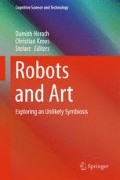Abstract
This text examines Doepner’s individually realized works as well as his works within different art collectives from the early 1990s up until today, work that spans the broad field of technology-based art: Van Gogh TV/Piazza Virtuale; Ikit; Playground Robotics: When Robots Play; When Robots Draw: At The Borderline Between Human and Machine; Robot Partner; Living Rooms—Happy End of the 21st Century; Automated Table Modification; DrillBot; NoiseBot, and others. The text focuses on Doepner’s artistic explorations of today’s prevalent reception, use and impact of technology as a materialization of certain systems and techniques that critically influence our daily lives.
Are “Friends” Electric? is a song by English band Tubeway Army from their 1979 album Replicas. The song was written and produced by Gary Numan, the band’s frontman and lead vocalist.
Access this chapter
Tax calculation will be finalised at checkout
Purchases are for personal use only
References
The concept of medium specificity was, in the mid-20th century, most notoriously propagated by the American art critic Clement Greenberg
I am referring to three oft-cited conceptualizations of the post-media/post-medium condition. According to Lev Manovich, various cultural and technological developments rendered meaningless one of the key concepts of modern art—that of a medium; still, the old media-based typology of art persists (Manovich L (2001) Post-media Aesthetics. http://manovich.net/index.php/projects/post-media-aesthetics. Accessed 9 March 2015). Peter Weibel’s post-media condition brings about not only the equalization of individual media (as compared to the historic primacy of painting), but also new combinations and mixtures of artistic media (Weibel P (2012) The Post-media Condition. http://www.metamute.org/editorial/lab/post-media-condition. Accessed 9 March 2015). Rosalind Krauss derives from a critique of Greenberg’s media specificity, which is tied to a physical element (flatness of painting, three-dimensional sculpture, etc.), and elaborates on the “knights of the medium” whose works re-invent what art can achieve through a particular medium (Krauss R (2000) A Voyage on the North Sea: Art in the Age of the Post-Medium Condition. Thames & Hudson, London)
Louis Althusser’s concept of ideological “interpellation” describes the moment and process by which ideology constitutes individuals as subjects. According to Althusser, the ideological social and political institutions and the discourses they propagate “hail” the individual in social interactions, giving him/her his/her identity. By recognizing him/herself in that “hail”, the concrete individual is “always already interpellated” as a subject
Parallel to these art historical and cultural policy operations that split the art field into different (media-based) branches, I understand the splintering of the art (field) into specific niches and novelties as being determined as well by market operations, through which differences can be easier economized
See: http://www.medienkunstnetz.de/works/piazza-virtuale. Accessed 20 Feb 2015
In the year 1994, Nicolas Anatol Baginsky invited me to work with him in Hamburg for a production with NVA (NVA was founded in 1992 by Angus Farquhar, a former member of the industrial music group Test Dept) at Kampnagel, and on that occasion I also built my first publicly performing machine Butter-Fliege. In 1995, I worked with Nick and Barry Schwartz on the I-Beam Music project as well as assisting at Chico MacMurtrie’s The Amorphic Evolution project, both at “cultural factory” Kampnagel in Hamburg
Blue House [Blaues Haus] functioned as the f18 living, working and public space, where we were organizing exhibitions and public events presenting our work and the work of other Hamburg-based artists (Testsequel Present T1, 1997; Testsequel Present T2, 1998)
At Kampnagel, Hamburg, f18 realized the motorized and computer-controlled installation Drop Outs within the framework of the Junge Hunde program, 1998; and generalpark.de: A Soap-Opera Between Machines, Computer, Video and Sound, 1999
Playground Robotics: When Robots Play was displayed at the Kornhausforum in Bern; Kunstmuseum and Altes Spital in Solothurn; and Plug. In in Basel. The exhibition series was produced by the Migros Culture Percentage. Later that year, an excerpt of this exhibition project was presented at the Kapelica Gallery in Ljubljana, Slovenia
Ammann K, Mollet J (2004) Wenn Roboter zeichnen. http://www.kunstmuseum-so.ch/wenn-roboter-zeichnen. Accessed 28 Feb 2015
The Living Rooms—Happy End of the 21st Century was produced by the SMARt 2006
Automated Table Modification was produced by the Kapelica Gallery, Ljubljana
Author information
Authors and Affiliations
Editor information
Editors and Affiliations
Rights and permissions
Copyright information
© 2016 Springer Science+Business Media Singapore
About this chapter
Cite this chapter
Doepner, S., Jurman, U. (2016). Robot Partner—Are Friends Electric?. In: Herath, D., Kroos, C., Stelarc (eds) Robots and Art. Cognitive Science and Technology. Springer, Singapore. https://doi.org/10.1007/978-981-10-0321-9_20
Download citation
DOI: https://doi.org/10.1007/978-981-10-0321-9_20
Published:
Publisher Name: Springer, Singapore
Print ISBN: 978-981-10-0319-6
Online ISBN: 978-981-10-0321-9
eBook Packages: EngineeringEngineering (R0)

